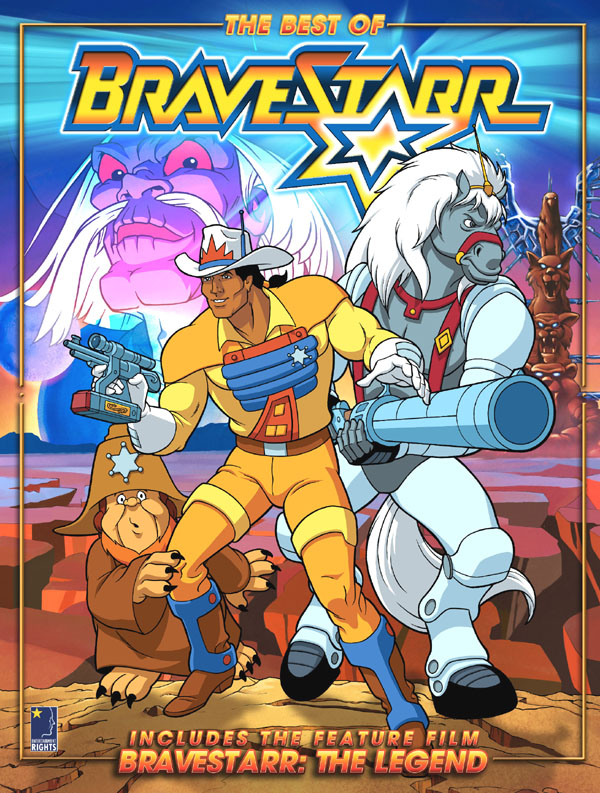Previously I reported on
Bravestarr, the TV series about the futuristic marshal of the planet New Texas. Now I've seen
The Best of Bravestarr DVD, which includes the movie
Bravestarr: The Legend and five episodes of the show. Here are some reviews of the DVD:
Animated Views: The Best of BravestarrPop Matters: The Best of BravestarrDVD Verdict: The Best of BravestarrAnd here are a few of my thoughts:
The goodThe frontier mixture of humans, aliens, and robots is well-conceived and rich with possibilities.The four main characters--easygoing Bravestarr, ornery Thirty/Thirty, passionate J.B., and comical Fuzz--are well-matched and balanced.With his Western gear, attitude, and drawl, Bravestarr is more a cowboy than an Indian. His role is a nicely nontraditional one.Thirty/Thirty the "equestroid" is perhaps the most complex and interesting character of the bunch. As one reviewer put it, "Bravestarr’s main sidekick is a robotic horse named Thirty/Thirty with whom the hero both speaks to and rides. The power-dynamic of the duo is slightly more perverse than, say, the one seen between He-Man and Cringer, though, because Thirty/Thirty is capable of walking as a biped."The music gets the first credit in the movie and rightly so, because it's striking .The badThe characters each have one or two dimensions in the movie but become shallower, not deeper, in the series.Bravestarr has too many abilities. He uses a ray gun, energy shield, cyber-tomahawk, and night-vision goggles. He's the fastest draw in the West. He's acrobatic enough to dodge blasts. And he has his four spirit powers. These ten options are seven or eight more than a good character should have. Other than the spirit powers, there's no evidence that Bravestarr and his mentor Shaman are Indians. They show no sign of having Indian values, beliefs, or customs. They never even call themselves Indians. The animation is acceptable but limited in the movie and grows worse in the series.Most of the action is lame--ray guns vs. monsters a la Godzilla--and the moralizing at the end is painfully obvious.The uglyAnimated Views recounts the beginnings of the series:The origin of Bravestarr can actually be traced back to about 1984 during the development of the Ghostbusters show that Filmation did. Lou Scheimer liked something about a character named Tex Hex, who was designed as a lackey for Ghostbusters baddie Prime Evil. Ol’ Tex was put on the backburner for the time being, until another show could be developed that would do him better justice. That show turned out to be Bravestarr, a series that also fulfilled Scheimer’s desire to spotlight a Native American hero, and mixing western themes with science fiction.So Bravestarr came into being not because he was an inspiring idea, but because Tex Hex was. The show basically existed to showcase the villain. That's ugly part one.
On the DVD commentary, Scheimer said something to the effect that Tex Hex was the best villain he'd seen since He-Man's arch-foe Skeletor. Which is basically saying nothing. It's like saying the Spot is the greatest Spider-Man villain since the Gibbon. Or the Turtle is the greatest Flash villain since the Rainbow Raider. Or Tyroc is the greatest Legionnaire since Matter-Eater Lad.
That's ugly part two.
So Scheimer wanted to do a series with a Native American. His solution was an Indian with no Indian traits whatsoever except his spirit powers. An Indian who was basically a blank slate. In fact, if his mentor hadn't looked like an Indian, Bravestarr could've passed as any brown-skinned minority.
That's ugly part three.
In sum, Bravestarr is a series that existed for the wrong reasons. Scheimer had what he thought was a good character--Tex Hex--and threw in a generic Indian counterpart to keep him busy. Here's a helpful hint: If you're going to spend millions creating a TV series, make sure your main character is deeper and richer than the supporting characters.
Conclusion
Bravestarr gets points for making the Native character a nontraditional hero: a cowboy-style marshal. It loses points for making him a generic Indian with no history or culture. The result is a wash.
And so it goes with the rest of the series. Interesting concept and characters, mediocre execution. On the DVD, storyboard coordinator Rob Lamb said he hopes Bravestarr "will take its place in the halls of achievement in animation." If there's a hall for wasted potential, for unusual concepts that never quite gel, Bravestarr should be there.
Check out the DVD if you're curious. The movie isn't bad. I give it about a 7.5 of 10.
But if you're like me, you'll be done with the series after one movie and five TV episodes. That's enough Bravestarr for anyone.
For more on the subject, see TV Shows Featuring Indians.



No comments:
Post a Comment